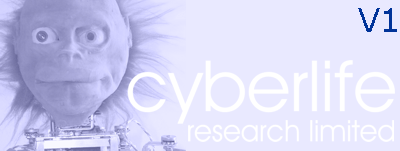
|
|
|
In mammals, V1 is the map at the back of the brain where visual signals first enter the cortex. We know that V1 is sensitive to the orientation of edges, but we don't really know what this information is used for. It's generally assumed that V1 is the fist stage in a pipeline that extracts visual features (first edges, then later corners and simple shapes). However, there are a number of real difficulties with this classical model. One interesting oddity is that V1 sends signals out to the Superior Colliculus, and so must control eye movements. This doesn't fit with the traditional view of V1 as a purely sensory area. It may be that this has something to do with binocular vision, but for Lucy 1 I tried an alternative hypothesis to see where it might lead. Essentially, I assumed that V1's task is to control eye movements to bring the eye within an object's boundary.
Lucy's V1 still has to conform with what we know for sure about the real V1, of course, which is that it becomes sensitive to the orientation of lines and edges. The image above shows a tiny portion of the cells in Lucy's V1, teased apart so that the pattern of each neuron's dendrites (input wires) can be seen. The first picture shows the roughly circular receptive fields of the cells just after Lucy is "born", while the second shows them after she has been exposed to the visual world for a while. Usually she would sit in front of a computer screen and watch a series of patterns, but she could just as easily have watched the real world go by. The image shows that each cell has spontaneously become specialised for responding to lines of a particular orientation. The third picture shows what happens if Lucy is only ever allowed to see horizontal lines (it's ok to be this cruel to robots - so far, anyway!). In a pure visual scene, lines are almost the only regularities that can be discerned. Lines are what Lucy's can learn about, so lines are what it does learn about. The diagram below shows the neural structures in Lucy's retina and V1. Her V1 does more than just detect lines - it plays a part in controlling eye movements as part of the process of object recognition.
Note: Lucy's orientation selectivity, and that presented in most neuroscientific theories on the subject, fail to capture an important and glaring (but little-discussed) fact about the distribution of real orientation-selective cells. But a discussion of this will have to wait for another day. |
Copyright © 2004 Cyberlife Research Ltd. |